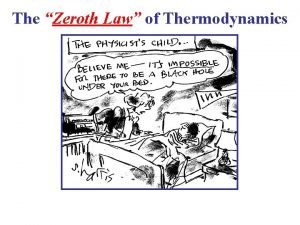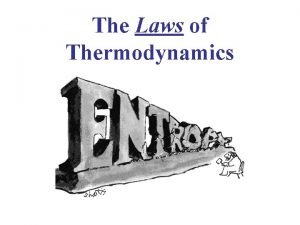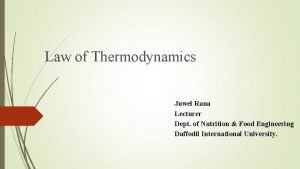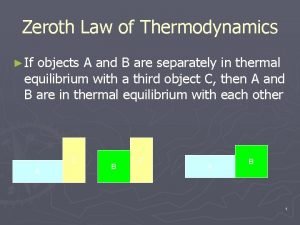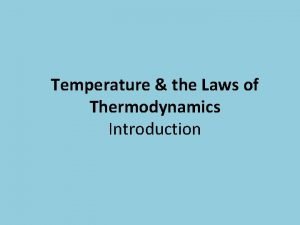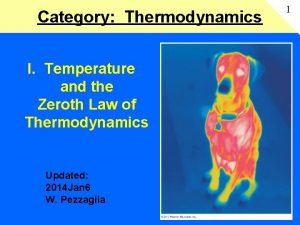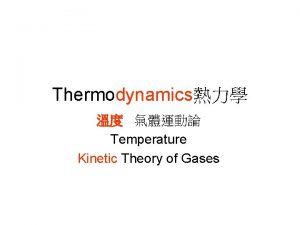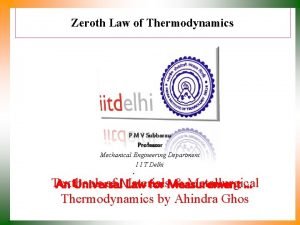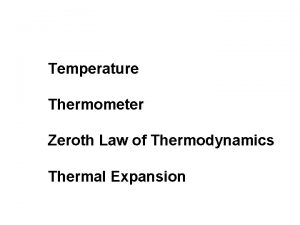Thermodynamics Unit2 Zeroth Law of Thermodynamics and Applications









- Slides: 9

Thermodynamics Unit-2 Zeroth Law of Thermodynamics and Applications

OUTCOME OF SESSION - IV Diathermic wall Zeroth Law of Thermodynamics Temperature Concepts International Practical Temperature Scale.

Diathermic Wall: A wall which is impermeable to the flow of heat is an adiabatic wall, where as a wall which permits the flow of heat is a diathermic wall. Thus heat flow takes place through this wall. Zeroth Law of Thermodynamics: It states that when two bodies have equality of temperature with the third body, they in turn have equality of temperature with each other. When a body A is in thermal equilibrium with body B and also separately with body C then B and C will be in thermal equilibrium with each other.

Temperature Scales: Two scales are commonly used for measurement of temperature namely, Fahrenheit after Gabriel Fahrenheit (16861736) and Celsius. The Celsius scale was formerly called the centigrade scale but is now designated the Celsius scale after Anders Celsius (17011744), the Swedish astronomer who devised this scale. IN SI units of temperature scale we use absolute temperature scale or absolute scale of temperature which comes from second law of thermodynamics and its unit is Kelvin. The absolute scale is related the Celsius scale is the Kelvin scale after William Thompson, 1824 -1907, who is also known as Lord Kelvin and is designated K. The relation is K=o. C + 273. 15

In 1967 the CGPM defined the Kelvin as 1/273. 16 of the temperature at the triple point of water. In order to obtain a quantitative measure of temperature a reference body is used, and a certain physical characteristic of this body which changes with temperature is selected. The changes in the selected characteristic may be taken as an indication of change in temperature. The selected characteristic is called thermometric property and the reference body which is used in the determination of temperature is called thermometer.

A very common thermometer consists of a small amount of Mercury in an evacuated capillary tube. In this case the extension of the mercury in the tube is used as thermometric property. A common Mercury Thermometer Mercury-in-Glass Thermometer

Thermometers and Thermometric Properties Thermometric property Symbol 1) Constant volume gas thermometer pressure p 2) Constant pressure gas thermometer volume V 3) Electrical Resistance thermometer Resistance R 4) Thermocouple Thermal emf e 5) Mercury in glass thermometer Length Thermometer L

Presently temperature of triple point of water which is an easily reproducible state is now the standard fixed point of thermometry. International practical temperature scale: an international temperature scale was adopted at the seventh general conference on weights and measures held in 1927. It was not to replace the Celsius or ideal gas scales, but to provide a scale that could be easily and rapidly used to calibrate scientific and industrial instruments. International practical scale agrees with Celsius scale at the defining fixed points listed in following table.

Temperature of Fixed Points Temperature Normal boiling point of oxygen -182. 97 Triple point of water (standard) +0. 01 Normal boiling point of water 100. 0 Normal boiling point of sulphur 444. 60 Normal melting point antimony 630. 50 Normal melting point of silver 960. 80 Normal melting point of gold 1063. 0 0 C
 Zeroth law of thermodynamics definition
Zeroth law of thermodynamics definition Third law of thermodynamics
Third law of thermodynamics State second law of thermodynamics
State second law of thermodynamics Zeroth law of thermodynamics
Zeroth law of thermodynamics Zeroth law of thermodynamics
Zeroth law of thermodynamics Renal excretion ratio
Renal excretion ratio Newton's first law and second law and third law
Newton's first law and second law and third law Newton's first law and second law and third law
Newton's first law and second law and third law Boyle's law charles law avogadro's law
Boyle's law charles law avogadro's law Constant of avogadro's law
Constant of avogadro's law
